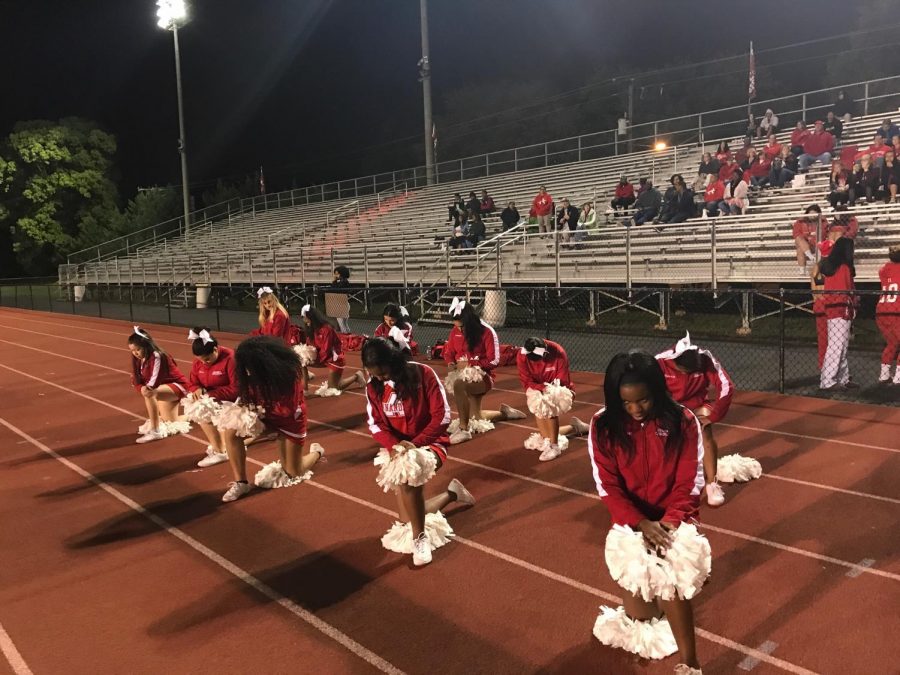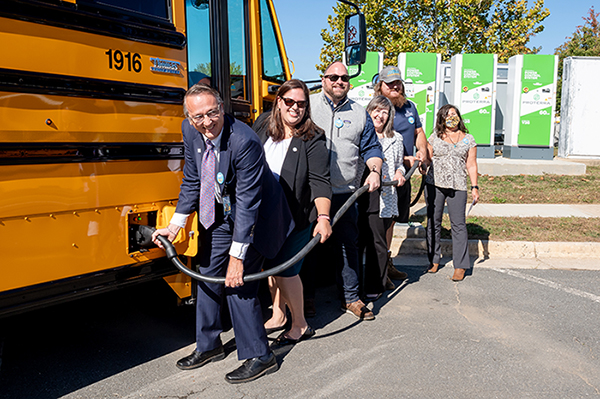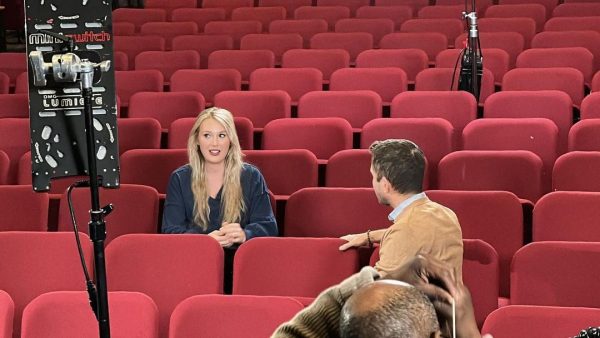Sit down to stand up
Junior Ammy Valdivia stared intently ahead as she linked arms with her fellow varsity cheerleading sisters. The crowd grew quiet as the choir began singing the national anthem during the Homecoming game. Looking at each other, the girls began kneeling. One by one. Valdivia took in a deep breath as she stepped down, bracing herself for some sort of backlash. She, along with the others, remained kneeling for the entire anthem.
The varsity cheerleaders kneeling during the anthem as part of a movement of student athletes who protest racial and social injustices in America.
“With everything going on in America it didn’t feel right to stand for the anthem. A lot of people on the team have been faced with some type of discrimination, even a few days leading up to the football game,” junior Isatu Kargbo said. “We asked ourselves ‘why should we stand for a country that doesn’t respect people of different races?’”
These conversations started long before the Homecoming game: in the locker room, car rides home, walks to practice and back again. The girls on the team each cite their own personal reasons for kneeling, but the cheer team, like many other high school sports teams, were inspired to take a knee during the national anthem by professional athletes.
“I was inspired by hearing about football players kneeling during the anthem,” Valdivia said. “It actually takes a lot for me to kneel, because I always have the people who fight for our country in mind, who I give all respect to.”
An increased number of professional athletes of all sports have joined former San Francisco quarterback Colin Kaepernick’s protest against police brutality especially after President Donald Trump’s heated comments against athletes who knelt during the anthem.
Kaepernick’s protest began over a year ago when he sat on the bench during protests, but he later transitioned to kneeling, saying that he was doing so to show more respect for military veterans, which later turned out to be a much more iconic pose. He cited his reasons for doing so because he was not going to “stand up to show pride in a flag or country that oppresses people of color,” Kaepernick said in a press conference after first sitting out during an anthem.
Kaepernick, like several other athletes who have sat out during the anthem, has received a lot of backlash for not standing during the national anthem. Many people believe sitting out during the anthem as disrespectful, especially to veterans and those who serve.
“If you want to protest Trump that is fine, but I think kneeling for the anthem is not the way to go about it,” said senior Hunter Swedish. “I just think there are too many people risking their lives for us. Standing for the anthem is our way to respect them.”
The girls on the varsity cheerleading team do not take kneeling lightly, rather, many of them are very aware of how their actions could be perceived, but they believe that kneeling holds a greater purpose.
“I don’t mean to disrespect those who have fought for our country. I respect those people so much, but I take a knee because it’s my freedom to do so, and I just feel like this country has showed a lot of disrespect towards me, towards my family and towards other races,” Valdivia said.
More athletes, both professional and high school, joined Kaepernick’s peaceful demonstration during the anthem when President Trump called any player who took a knee a “Son of a bitch.” He further told NFL owners to fire players who refused to stand for “The Star-Spangled Banner.”
Although more athletes began to sit after Trump’s inflamed comments, those who are protesting claim that they are sitting not because of Trump, but what Trump’s comments represent: a reality where minorities’ voices are suppressed and are attacked for protesting.
The movement to take a knee during the national anthem or to stand with arms locked in silent protest follows a long tradition of sports stars standing up for what they believe in. Some have accused this movement of being unpatriotic and that politics should be kept out of sports.
“It is about respect for our flag and respect for our soldiers, our first line like our fire fighters, police officers as well,” Swedish said.
However, protests against national symbols has not been isolated to just kneeling during the anthem, but students have also acted out by not participating in the pledge of allegiance.
Senior Cecelia Joseph has not stood for the anthem all year, which she cites as her way to protest racial injustice in the U.S.
“I think people perceive people who sit as disrespectful and think that everyone who sits hates America, but that’s not why we sit,” Joseph said. “I sit because I know America can do better and that I feel like we need to bring awareness to the racial issues that we face.”
The professional athletes who have knelt have faced tremendous backlash by sitting down. Kaepernick, who was the quarterback for the San Francisco 49ers, was unsigned in 2017, and now has focused his career on his organization, which works to fight oppression of all kinds through education and social activism. One of his major initiatives is his $1 million pledge, which he has split amongst several organizations that work with “oppressed communities.”
Joseph and other students who choose to sit during the pledge are protected by the county’s Students Rights and Responsibilities.
Under the Supreme Court case West Virginia State Board of Education v. Barnette (1943), the Supreme Court upheld the Free Speech Clause of the First Amendment, which protects students from being forced to salute the American flag during the Pledge of Allegiance.
The VHSL guidelines do not force students to stand as well. However, several private schools across the country have forced athletes to stand during the anthem.
Despite the legality of their dissent, students still deal with backlash.
“I’ve been told that my actions are ‘disgraceful’ and cheerleaders have been screamed at,” Valdivia said. “But personally, I don’t feel uncomfortable for kneeling. There was one time where I had one person come to the gate and tell me I’m ‘disrespectful,’ and ask my coaches if this is even allowed. We had a short conflict. But that person does have their right to show their opinion.”
Despite the opposition against sitting and kneeling during the anthem and pledge, the students involved in the protest still have strong feelings for America, and are protesting the discrimination they see prevalent.
“I’m sitting because I’m tired of racial oppression. It’s become too diminishing and it’s embarrassing to our country because of our history. I will not tolerate disrespect of minorities and stay silent,” Joseph said. “I sit because if I stand, I feel like I’m being ignorant and supporting a flag that doesn’t support me and wants to see me fail. I sit because I can and because it’s my right. I sit to save the voices of those who’ve been silenced, and because I truly love America.”

Senior Aseal Saed is currently the Co-Editor in Chief of The A-Blast. This is her fourth year on staff. Her previous positions were as In-Depth Editor...












Kimberly • Oct 27, 2017 at 3:55 pm
Your lead photo is inaccurate. Only one cheerleader knelt at the Mt Vernon game during the national anthem. Look at the stands – the crowd is sitting. Truth in reporting please.
Eileen Kugler • Oct 25, 2017 at 9:53 am
Thank you for this thoughtful article about an important issue. The students at AHS consistently make me proud — from the journalists to the athletes and cheerleaders.
Eileen Kugler, former AHS parent